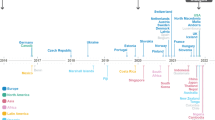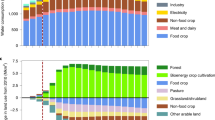Abstract
Delaying climate mitigation action and allowing a temporary overshoot of temperature targets require large-scale carbon dioxide removal (CDR) in the second half of this century that may induce adverse side effects on land, food and ecosystems. Meanwhile, meeting climate goals without global net-negative emissions inevitably needs early and rapid emission reduction measures, which also brings challenges in the near term. Here we identify the implications for land-use and food systems of scenarios that do not depend on land-based CDR technologies. We find that early climate action has multiple benefits and trade-offs, and avoids the need for drastic (mitigation-induced) shifts in land use in the long term. Further long-term benefits are lower food prices, reduced risk of hunger and lower demand for irrigation water. Simultaneously, however, near-term mitigation pressures in the agriculture, forest and land-use sector and the required land area for energy crops increase, resulting in additional risk of food insecurity.
This is a preview of subscription content, access via your institution
Access options
Access Nature and 54 other Nature Portfolio journals
Get Nature+, our best-value online-access subscription
$29.99 / 30 days
cancel any time
Subscribe to this journal
Receive 12 digital issues and online access to articles
$119.00 per year
only $9.92 per issue
Buy this article
- Purchase on Springer Link
- Instant access to full article PDF
Prices may be subject to local taxes which are calculated during checkout



Similar content being viewed by others
Data availability
Data used in the study are available at the repository https://doi.org/10.5281/zenodo.5078072.
Code availability
Code used in the study is available at the repository https://doi.org/10.7910/DVN/ZDXB6F.
References
Rogelj, J. et al. A new scenario logic for the Paris Agreement long-term temperature goal. Nature 573, 357–363 (2019).
Anderson, K. & Peters, G. The trouble with negative emissions. Science 354, 182–183 (2016).
Peters, G. P. & Geden, O. Catalysing a political shift from low to negative carbon. Nat. Clim. Change 7, 619–621 (2017).
Clarke, L. et al. International climate policy architectures: overview of the EMF 22 international scenarios. Energy Econ. 31, S64–S81 (2009).
Kriegler, E. et al. The role of technology for achieving climate policy objectives: overview of the EMF 27 study on global technology and climate policy strategies. Clim. Change 123, 353–367 (2014).
Clarke, L. K. J. et al. in Climate Change 2014: Mitigation of Climate Change (eds Edenhofer, O. et al.) 413–510 (IPCC, Cambridge Univ. Press, 2014).
World Energy Outlook 2015 (IEA, 2015).
van Vuuren, D. et al. A new scenario framework for climate change research: scenario matrix architecture. Clim. Change 122, 373–386 (2014).
Meinshausen, M. et al. Greenhouse-gas emission targets for limiting global warming to 2 °C. Nature 458, 1158–1162 (2009).
Matthews, H. D., Gillett, N. P., Stott, P. A. & Zickfeld, K. The proportionality of global warming to cumulative carbon emissions. Nature 459, 829–832 (2009).
Fuss, S. et al. Betting on negative emissions. Nat. Clim. Change 4, 850–853 (2014).
Shue, H. Climate dreaming: negative emissions, risk transfer, and irreversibility. J. Hum. Rights Environ. 8, 203–216 (2017).
Williamson, P. Emissions reduction: scrutinize CO2 removal methods. Nature 530, 153–155 (2016).
Smith, P. et al. Biophysical and economic limits to negative CO2 emissions. Nat. Clim. Change 6, 42–50 (2016).
Popp, A. et al. Land-use futures in the Shared Socio-economic Pathways. Glob. Environ. Change 42, 331–345 (2017).
Field, C. B. & Mach, K. J. Rightsizing carbon dioxide removal. Science 356, 706–707 (2017).
Boysen, L. R. et al. The limits to global-warming mitigation by terrestrial carbon removal. Earth’s Future 5, 463–474 (2017).
Morrow, D. & Svoboda, T. Geoengineering and non-ideal theory. Public Aff. Q. 30, 83–102 (2016).
Fujimori, S., Rogelj, J., Krey, V. & Riahi, K. A new generation of emissions scenarios should cover blind spots in the carbon budget space. Nat. Clim. Change 9, 798–800 (2019).
Fuss, S. et al. Negative emissions—Part 2: Costs, potentials and side effects. Environ. Res. Lett. 13, 063002 (2018).
Bauer, N. et al. Global energy sector emission reductions and bioenergy use: overview of the bioenergy demand phase of the EMF-33 model comparison. Clim. Change 163, 1553–1568 (2018).
Roe, S. et al. Contribution of the land sector to a 1.5 °C world. Nat. Clim. Change 9, 817–828 (2019).
Hanssen, S. V. et al. The climate change mitigation potential of bioenergy with carbon capture and storage. Nat. Clim. Change 10, 1023–1029 (2020).
Hasegawa, T. et al. Food security under high bioenergy demand toward long-term climate goals. Clim. Change 163, 1587–1601 (2020).
Ohashi, H. et al. Biodiversity can benefit from climate stabilization despite adverse side effects of land-based mitigation. Nat. Commun. 10, 5240 (2019).
Riahi, K. et al. Locked into Copenhagen pledges — Implications of short-term emission targets for the cost and feasibility of long-term climate goals. Technol. Forecast. Soc. Change 90, 8–23 (2015).
Rogelj, J. et al. in IPCC Special Report on Global Warming of 1.5 °C (eds Masson-Delmotte, V. et al.) 93–174 (WMO, 2018).
Luderer, G. et al. Residual fossil CO2 emissions in 1.5–2 °C pathways. Nat. Clim. Change 8, 626–633 (2018).
McCollum, D. L. et al. Energy investment needs for fulfilling the Paris Agreement and achieving the Sustainable Development Goals. Nat. Energy 3, 589–599 (2018).
Tebaldi, C. & Knutti, R. The use of the multi-model ensemble in probabilistic climate projections. Phil. Trans. R. Soc. A 365, 2053–2075 (2007).
Thompson, S. G. & Higgins, J. P. T. How should meta-regression analyses be undertaken and interpreted? Stat. Med. 21, 1559–1573 (2002).
Fujimori, S. et al. Inclusive climate change mitigation and food security policy under 1.5 °C climate goal. Environ. Res. Lett. 13, 074033 (2018).
Fuhrman, J., McJeon, H., Doney, S. C., Shobe, W. & Clarens, A. F. From zero to hero? Why integrated assessment modeling of negative emissions technologies is hard and how we can do better. Front. Clim. 1, 11 (2019).
Nemet, G. F. et al. Negative emissions—Part 3: Innovation and upscaling. Environ. Res. Lett. 13, 063003 (2018).
Realmonte, G. et al. An inter-model assessment of the role of direct air capture in deep mitigation pathways. Nat. Commun. 10, 3277 (2019).
Beerling, D. J. et al. Farming with crops and rocks to address global climate, food and soil security. Nat. Plants 4, 138–147 (2018).
High Level Review of a Wide Range of Proposed Marine Geoengineering Techniques (GESAMP, 2019).
Fujimori, S. et al. SSP3: AIM implementation of Shared Socioeconomic Pathways. Glob. Environ. Change 42, 268–283 (2017).
Fujimori, S., Masui, T. & Matsuoka, Y. AIM/CGE [Basic] Manual (Tsukuba Center for Social and Environmental Systems Research, NIES, 2012).
Hasegawa, T., Fujimori, S., Ito, A., Takahashi, K. & Masui, T. Global land-use allocation model linked to an integrated assessment model. Sci. Total Environ. 580, 787–796 (2017).
Frank, S. et al. Reducing greenhouse gas emissions in agriculture without compromising food security? Environ. Res. Lett. 12, 105004 (2017).
Fricko, O. et al. The marker quantification of the Shared Socioeconomic Pathway 2: a middle-of-the-road scenario for the 21st century. Glob. Environ. Change 42, 251–267 (2017).
Havlík, P. et al. Climate change mitigation through livestock system transitions. Proc. Natl Acad. Sci. USA 111, 3709–3714 (2014).
Keramidas, K., Kitous, A., Després, J. & Schmitz, A. POLES-JRC Model Documentation (JRC, 2017).
Popp, A. et al. Land-use protection for climate change mitigation. Nat. Clim. Change 4, 1095–1098 (2014).
Bodirsky, B. L. et al. Reactive nitrogen requirements to feed the world in 2050 and potential to mitigate nitrogen pollution. Nat. Commun. 5, 3858 (2014).
Emmerling, J. et al. The WITCH 2016 Model - Documentation and Implementation of the Shared Socioeconomic Pathways (FEEM Working Paper No. 42, 2016).
Hasegawa, T. et al. Risk of increased food insecurity under stringent global climate change mitigation policy. Nat. Clim. Change 8, 699–703 (2018).
Fujimori, S. et al. A multi-model assessment of food security implications of climate change mitigation. Nat. Sustain. 2, 386–396 (2019).
Acknowledgements
T.H., S. Fujimori and K.O. were supported by the Environment Research and Technology Development Fund (JPMEERF20202002 and JPMEERF20211001) of the Environmental Restoration and Conservation Agency of Japan and Sumitomo Foundation. T.H. was supported by the Ritsumeikan Global Innovation Research Organization (R-GIRO), Ritsumeikan University. P.R. and R.S. were supported by the Brazilian National Council for Scientific and Technological Development (CNPq). All authors excluding J.D., K.K. and F.F. received funding from the European Union’s Horizon 2020 research and innovation programme under grant agreement no. 821471 (ENGAGE).
Author information
Authors and Affiliations
Contributions
T.H. designed the research, created figures and wrote the draft of the paper; S. Fujimori, V.K., D.v.V. and K.R. designed the scenario protocol; T.H. and S. Fujimori carried out analysis of the modelling results with notable contributions from T.H., S. Fujimori, Y.O., K.O. (AIM/CGE), P.R., R.S. (COFFEE), M.H. (IMAGE), S. Frank, M.G., B.v.R, A.-M.C., A.D., P.H., V.K. (MESSAGEix-GLOBIOM), J.D., K.K, F.F. (POLES), F.H., C.B., A.P. (ReMIND-MAgPIE), L.D. and J.E. (WITCH); all authors provided feedback and contributed to writing the paper.
Corresponding author
Ethics declarations
Competing interests
The authors declare no competing interests.
Additional information
Peer review information Nature Sustainability thanks John Antle and the other, anonymous, reviewer(s) for their contribution to the peer review of this work.
Publisher’s note Springer Nature remains neutral with regard to jurisdictional claims in published maps and institutional affiliations.
Supplementary information
Supplementary Information
Supplementary Notes 1–2, Figs. 1–4 and Tables 1–2.
Rights and permissions
About this article
Cite this article
Hasegawa, T., Fujimori, S., Frank, S. et al. Land-based implications of early climate actions without global net-negative emissions. Nat Sustain 4, 1052–1059 (2021). https://doi.org/10.1038/s41893-021-00772-w
Received:
Accepted:
Published:
Issue Date:
DOI: https://doi.org/10.1038/s41893-021-00772-w
This article is cited by
-
Careful selection of forest types in afforestation can increase carbon sequestration by 25% without compromising sustainability
Communications Earth & Environment (2024)
-
Trade-offs in land-based carbon removal measures under 1.5 °C and 2 °C futures
Nature Communications (2024)
-
Feeding climate and biodiversity goals with novel plant-based meat and milk alternatives
Nature Communications (2023)
-
Enhanced food system efficiency is the key to China’s 2060 carbon neutrality target
Nature Food (2023)
-
Understanding How Community Wellbeing is Affected by Climate Change: Evidence From a Systematic Literature Review
Environmental Management (2023)



